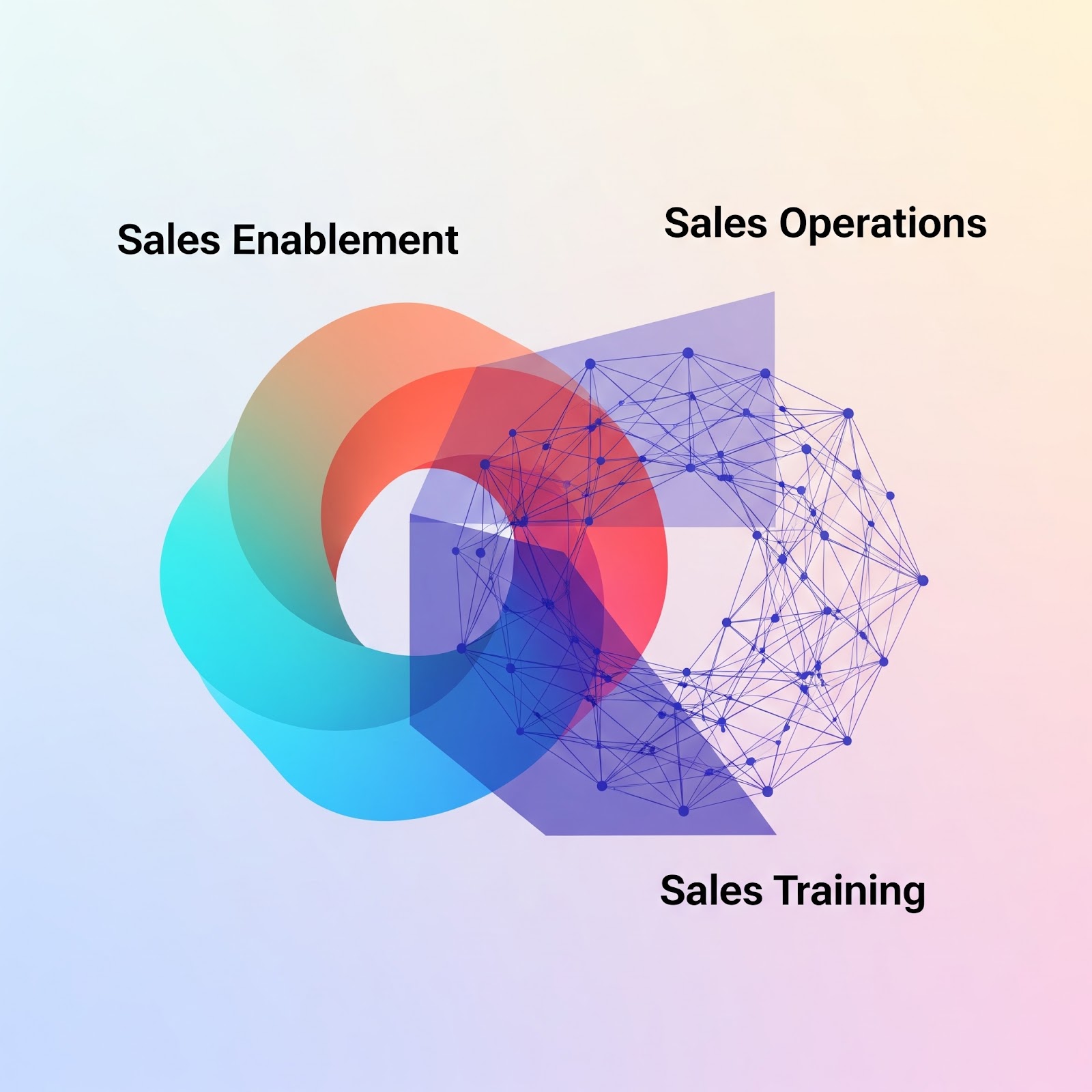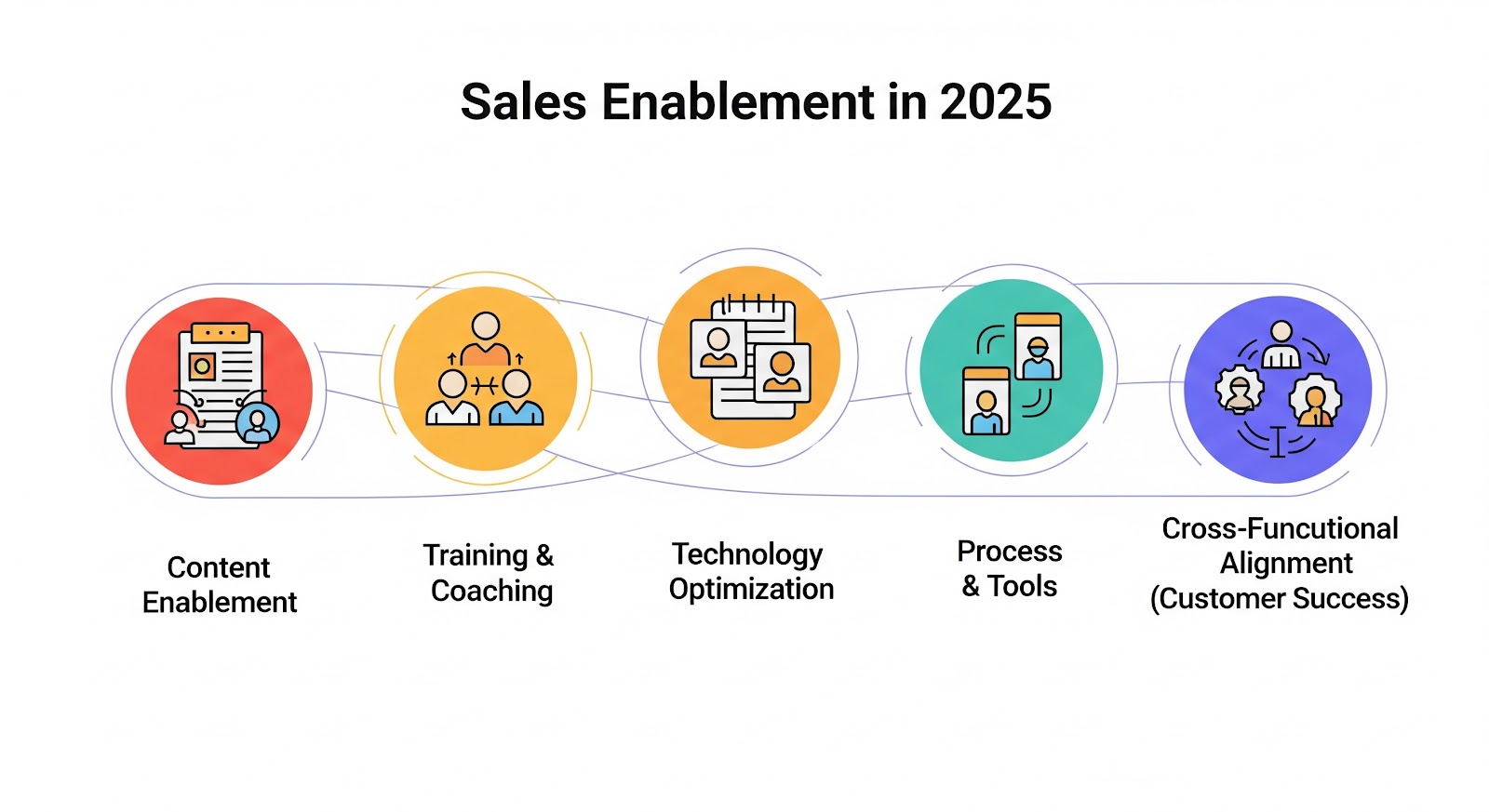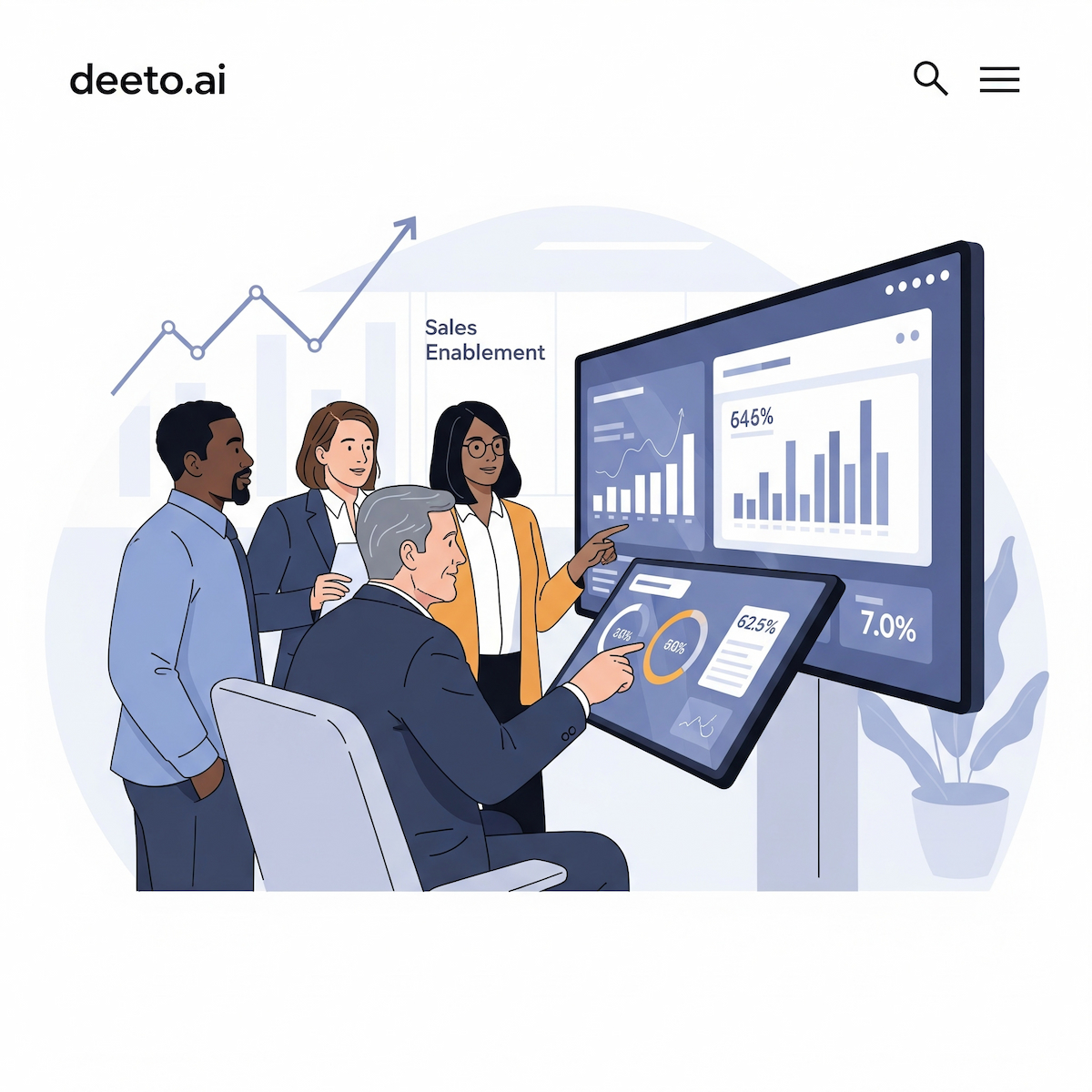If you're in B2B sales or marketing, you've probably heard the term “sales enablement” tossed around. But what does it actually mean, and more importantly, how do you use it to drive revenue?
Done right, sales enablement bridges the gap between sales and marketing. It gives reps the right content, insights, and training at the right time, so they can guide buyers more effectively and close deals with confidence.
In this article, you’ll learn:
- What sales enablement actually includes
- How it works across the sales cycle
- The role of modern sales enablement platforms
- How it empowers reps, buyers, and revenue teams alike
Let’s break it down.
What is sales enablement?
Sales enablement is the process of providing your sales team with the tools, content, training, and data they need to engage prospects and close deals effectively. It ensures that reps always have access to the right information at the right time, whether that's a case study, a pricing calculator, or a quick objection-handling guide.
The goal is simple: help sellers perform at a higher level by removing friction, improving consistency, and supporting every stage of the sales cycle.
Sales enablement vs. sales operations vs. sales training

These terms get mixed up often, but they serve different purposes.
- Sales enablement focuses on empowering reps with content, tools, and guidance to sell more effectively. It’s about strategy, messaging, and buyer engagement.
- Sales operations handles the backend: territory planning, quota setting, forecasting, CRM management, and overall process efficiency. It’s the engine room.
- Sales training is skill-building. It teaches reps how to pitch, negotiate, close, and improve over time. Enablement may deliver or reinforce training, but the two aren’t the same.
TL;DR: Enablement equips. Ops runs. Training teaches.
Each function plays a role in driving revenue, but sales enablement is the one that connects strategy to execution in the field.
Why sales enablement matters in 2025
Buyers now expect a self-directed, on-demand experience. They research on their own, involve at least 10 to 11 stakeholders, and generally don’t talk to sales until they’re already deep in the decision process. In fact, the average buyer is 70% of the way through the decision process by the time they engage company reps.
At the same time, AI and automation are transforming how sales teams operate. Reps are flooded with tools, dashboards, data, and content. Without clear direction, it’s noisy and impossible to personalize.
This is where sales enablement comes in.
It aligns your messaging, content, and training around the buyer journey. It uses data to show reps what to say, when to say it, and who to say it to. And it integrates with the tools your reps already use, so guidance fits naturally into their workflow.
In 2025, the teams that win are the ones who can move fast, speak with clarity, and meet buyers where they are. Sales enablement makes that possible.
Core pillars of sales enablement in 2025

Sales enablement is a system built on five critical pillars. In 2025, these areas define how effective your enablement strategy really is.
Content enablement: right message, right time
Sales enablement ensures that reps can easily find, personalize, and share the right content when it matters most, whether that’s a case study to build credibility or a comparison sheet to handle objections.
Enablement content includes:
- Product one-pagers and solution briefs
- Case studies and customer testimonials
- Competitor comparison sheets
- User-generated content
- Email and call scripts
- ROI calculators and pricing guides
- Demo decks and talk tracks
- Video snippets and product walkthroughs
- Industry-specific insights or playbooks
Essentially, any type of marketing collateral or sales resource that can be used to push deals forward is sales enablement content.
Training and coaching: building high-performing sales professionals
Top-performing reps aren’t just hired, they’re developed, which is why eablement delivers structured onboarding, ongoing product education, sales methodology training, and real-time coaching. The best programs also leverage call recordings and AI to surface coaching moments and reinforce skills at scale.
Technology and tools: the sales enablement software ecosystem
Enablement is powered by a stack of integrated tools:
- Content management platforms
- Conversational intelligence
- Learning management systems (LMS)
- Sales platforms (CRM, CPQ)
- AI-driven insights
The right tech gives your team visibility into what’s working, where deals are stalling, and how reps can improve without adding friction.
Process optimization: streamlining the sales journey
Most sales orgs get “lucky” with a few great sales hires, but struggle to replicate those results across their entire department.
You have to standardize how reps qualify leads, run demos, handle objections, and follow up. When these playbooks are clear and repeatable, it reinforces the training pillar and makes every rep more consistent in how they execute.
Process optimization also makes performance measurable. You can spot bottlenecks, test new approaches, and improve workflows without starting from scratch every time.
Cross-functional alignment (Sales, Marketing, Customer Success)
A huge factor in a successful strategy is your ability to connect the dots between teams. Marketing creates content that reps actually use, sales docs are aligned with Marketing’s positioning, and Customer Success shares feedback that sharpens messaging.
This is what turns one-off wins into a scalable, repeatable system.
Benefits of sales enablement for modern organizations
In 2023, 90% of companies had a dedicated sales enablement program. The reasonadoption is nearly unanimous now is that it’s a proven revenue driver. When implemented well, it impacts every part of the sales engine.
Increased win rates and deal velocity
Companies with a strong sales enablement strategy see 49% higher win rates on forecasted deals. Why? Because reps are more prepared, more relevant, and more confident at every stage of the sales cycle.
Improved rep productivity and onboarding
Sales enablement cuts onboarding time by 40% to 50%. New reps ramp faster, understand the process sooner, and become productive contributors in less time. For experienced reps, it eliminates time spent searching for content or guessing what works.
Enhanced buyer experience
When reps have the right tools, they can personalize every interaction, offering content, insights, and support tailored to the buyer’s needs. This helps qualified buyers make decisions faster and with greater confidence.
Better data and insights across the funnel
Sales enablement aligns sales, marketing, and customer success around shared goals and systems. That alignment produces cleaner data, clearer reporting, and more visibility into what’s driving (or blocking) revenue.
What is sales enablement software?
“Sales enablement software” is the category of tools designed to help sales teams sell more effectively. It’s not usually one single platform. Instead, it’s a combination of systems that support content delivery, training, coaching, engagement tracking, and sales process guidance.
Some companies use an all-in-one sales enablement platform. Others build a stack using specialized tools: one for content, another for training, another for deal insights or call coaching, and so on.
Key features to look for
Whether you’re using a single platform or a collection of tools, your sales enablement software should cover these capabilities:
- Content management and delivery: Centralize and organize sales content. Reps should be able to find the right materials quickly and know they’re up to date and on-brand.
- Training and onboarding tools: Deliver role-based training, product updates, and onboarding programs that help new reps ramp faster and keep your team sharp.
- Sales playbooks and in-workflow guidance: Help reps follow proven processes with embedded playbooks, qualification frameworks, and situational guidance.
- Buyer engagement insights: Track how buyers interact with shared content, emails, and meeting recordings. Use this data to prioritize outreach and improve follow-ups.
- CRM and tool integrations: Your enablement software should plug into your CRM, email, calendar, and call tools so reps aren’t wasting time switching systems.
- Analytics and performance dashboards: Measure what content gets used, which reps are engaging effectively, and where coaching is needed. Turn insights into action.
Top sales enablement tools
There’s no one-size-fits-all solution when it comes to sales enablement software. Some platforms are built for large, complex sales orgs. Others are leaner, AI-native tools built for speed, automation, and real-time insights.
Here’s a breakdown of two key categories: enterprise-level and AI-native options.
Enterprise-level tools
Enterprise sales enablement platforms are built for scale. They offer robust content management, onboarding systems, analytics, and deep integrations with CRMs and marketing tools.
A few examples:
- Highspot is known for its clean UX, in-context content delivery, and powerful analytics. It’s great for aligning sales and marketing around messaging.
- Seismic is a feature-rich platform that supports global teams, advanced personalization, and data-driven enablement strategies. It centralizes content management and automation, learning/coaching, sales planning, and sales intelligence.
- Showpad combines content, training, and coaching into one platform. It’s particularly strong in managing distributed sales teams and creating interactive sales experiences.
These tools are better for large or fast-scaling B2B orgs that need enterprise-grade control, customization, and global enablement infrastructure.
AI-native tools
AI-driven sales enablement tools are built with automation and intelligence at the core. They help teams work faster, get smarter insights, and personalize at scale. They’re less of all-in-one solutions, but solve one or two major challenges of sales enablement exceptionally well.
A few examples of AI-powered platforms for sales enablement:
- Deeto is a customer marketing and advocacy platform that automates UGC and customer feedback collection, content repurposing and distribution, reference matching for sales calls, ROI tracking, and advocacy programs.
- Gong is a conversation intelligence tool that analyzes sales calls, identifies deal risks, and surfaces coaching opportunities in real time.
- Salesloft is a sales engagement platform that uses AI to guide reps through multichannel cadences, prioritize tasks, and improve follow-through.
These kinds of tools are best for GTM teams that want real-time data, intelligent automation, and workflow acceleration without the bloat.
How Deeto fits into the modern sales enablement stack

Deeto brings a powerful and often overlooked layer to sales enablement: customer-led enablement.
Instead of relying solely on internal messaging or rep-driven content, Deeto helps you activate your happiest customers to do the talking through peer stories, user-generated content (UGC), and automated reference calls.
This creates a level of trust that no pitch deck or demo alone can replicate.
Customer-led enablement through peer stories and UGC
Deeto makes it easy to capture and distribute authentic stories from your best customers. That includes testimonials, case studies, review snippets (via G2 integration), and more. Reps can instantly pull relevant peer proof into their outreach, follow-ups, or deal cycles—without waiting for marketing to build it.
Enabling trust at scale with real-user validation
Modern buyers are skeptical. They want to hear from people like them before making a decision. Deeto puts real user voices into your sales process at scale. Whether it’s matching a prospect with a reference or sending a video from a similar customer, you create instant credibility and shorten the path to “yes.”
Sales, Marketing, and CS alignment
Deeto doesn’t just support sales; it connects the dots across your go-to-market teams.
- Marketing gets a scalable way to generate authentic content.
- Sales gets on-demand social proof that actually moves deals.
- Customer success gets involved in building advocacy, not just retention.
That’s why Deeto is quickly becoming a go-to tool in modern enablement stacks: it turns customer voice into a strategic asset across your entire revenue team.
Sales enablement metrics and KPIs to track
To know if your sales enablement efforts are working, you need to measure it. Most sales enablement software has more metrics than you actually need, though. The following five KPIs are the most important ones if you want to connect enablement activities to real revenue impact.
Sales content usage
Track which assets reps are using, how often, and at what stage. This shows what content actually supports deals and what you need to improve or cut out from your sales process and replace it with to make selling more effective.
In the early stages of implementation, it also shows you how many of your reps have adopted the software. If you see low content usage across the board, it probably means there aren’t enough people using it consistently. If that’s the case, look into why.
Win rate per stage
Don’t only look at your overall win rate. Break it down by stage to see where deals stall or drop off. This info helps you fine-tune your messaging, content, and coaching at critical points throughout the funnel.
Sales cycle length
A shorter sales cycle usually means better enablement. If reps have the right tools and buyers feel confident, decisions happen faster.
For instance, Deeto accelerates sales cycles by giving buyers instant access to peer validation. Instead of waiting weeks for a reference call, prospects hear from real users early, which eliminates doubts and speeds up the path to Closed Won.
If you’re using it properly (and using it enough), you should see a reduction in sales cycle time. If your software isn’t netting you that, it’s either an issue with team-wide adoption, the sales workflow itself, or the content you’re presenting to buyers.
Rep ramp time
Measure how long it takes new reps to become productive, on average. A strong enablement program and platform should cut this down significantly through structured onboarding and access to proven playbooks.
Buyer engagement levels
Track how buyers interact with shared content, emails, and calls. Tools like Deeto, Gong, and Salesloft can surface which reps are creating real interest and which touchpoints drive responses.
Final thoughts
Whether you're building your program from scratch or leveling up an existing one, choosing the right tools and partners makes all the difference. A platform like Deeto plays a pivotal role where trust, validation, and customer voice are what set your deals apart.
But the real power comes from tying it all together: content, training, technology, process, and cross-team alignment. That’s what modern sales enablement is all about.




